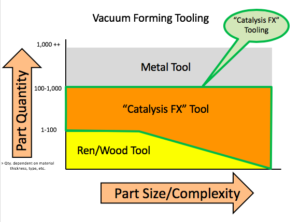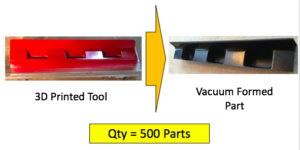As 3D printing is becoming more and more advanced at an exponential rate, this can raise some concerns related to accuracy and potential limitations. You might be comfortable and content with your conventional tooling. But, hear us out- just because it works, doesn’t mean it’s the best. At Catalysis, we strive to utilize this advancing technology to help our customers save time and money with our 3D printed tooling. We understand there are concerns and misconceptions about our business. We thought it would be helpful to layout some of those most common misconceptions and explain our business a little further.
Here are the most common misconceptions.
Misconception #1: Limited Volume/Quantity
 One of the most common misconceptions is the assumption that only a limited volume of parts can be completed with 3D printed tooling. We have developed a unique technology we refer to as the “Catalysis FX” Tool, which is a high quality solution for medium volume and high complex parts. As you can see from the chart, our “Catalysis FX” Tooling system is a quality solution for a required part volume between Ren/Wood Tooling and Metal Tooling.
One of the most common misconceptions is the assumption that only a limited volume of parts can be completed with 3D printed tooling. We have developed a unique technology we refer to as the “Catalysis FX” Tool, which is a high quality solution for medium volume and high complex parts. As you can see from the chart, our “Catalysis FX” Tooling system is a quality solution for a required part volume between Ren/Wood Tooling and Metal Tooling.
We recently completed a project for Avco Roofing that called for 500 vacuumed formed parts.

The picture shows a quarter inch ABS and no damage to the tool after 500 thermoformed parts! The 3D printed tool was used for Avco’s Catch-All System, which protects gutters and landscaping from trash and debris. Click here to view the Catch-All.
Misconception #2: Complexity Costs Money

If we can make a tool for medium volume parts with high complexity, that must mean it’s more expensive, right? The beauty of 3D printing is that it thrives on high complexity at no extra cost. That means that you can 3D print a part in any shape and any size. When considering tooling needs for a highly complex part, this makes 3D printed tooling a better option than traditional metal tooling. Metal tooling thrives on simplicity, 3D printing thrives on complexity.
Misconception #3: It’s Only For Small Parts
When you think of something being 3D printed, you might automatically think “small parts” and the potential limitations that our services provide. 3D printing might be an innovative technology, but it can only be used for smaller parts, right? Not always! The unique technology we developed called the “Catalysis FX” Tool has a maximum build area of 12 ft x 9 ft x 6 ft!
Misconception #4: Poor surface finish quality
If you are familiar with 3D printing, you might be concerned about poor surface quality when considering 3D printed tooling. Surface quality is a reasonable concern as a direct 3D printed surface print does not have high enough resolution for vacuum forming without substantial post processing. So, you might be more inclined to stick with a different solution. But, with our “Catalysis FX” Tool, we have minimal post processing to achieve required surface quality for vacuum forming.
Let’s take a look.
FDM Tool


Here we have an FDM Tool. You can see all the build layers, which doesn’t result in a desired clean & smooth finish.
“Catalysis FX” Tool

Here we have an example of a “Catalysis FX” Tool. With our “Catalysis FX” tool, you can see that the surface finish is nice and smooth.
Misconception #5: Not Uniform Strength In All Directions
Again, if you are familiar with 3D printing, you probably know there is limited strength in the Z print direction. With our “Catalysis FX” Tool, the tool process gives uniform strength in all directions! Catalysis proprietary developed resins infiltrated to the tool 3D print gives us the uniform strength in all directions.
So, there you have it. An explanation of our most common misconceptions. We understand the common concerns related to potential limitations of 3D printing, but we hope you found this information helpful. With our “Catalysis FX” Tooling system, we have been able to come up with a quality solution for medium volume and high complex parts. We are using the advanced 3D printing technology to provide our customers with best tooling solutions!
